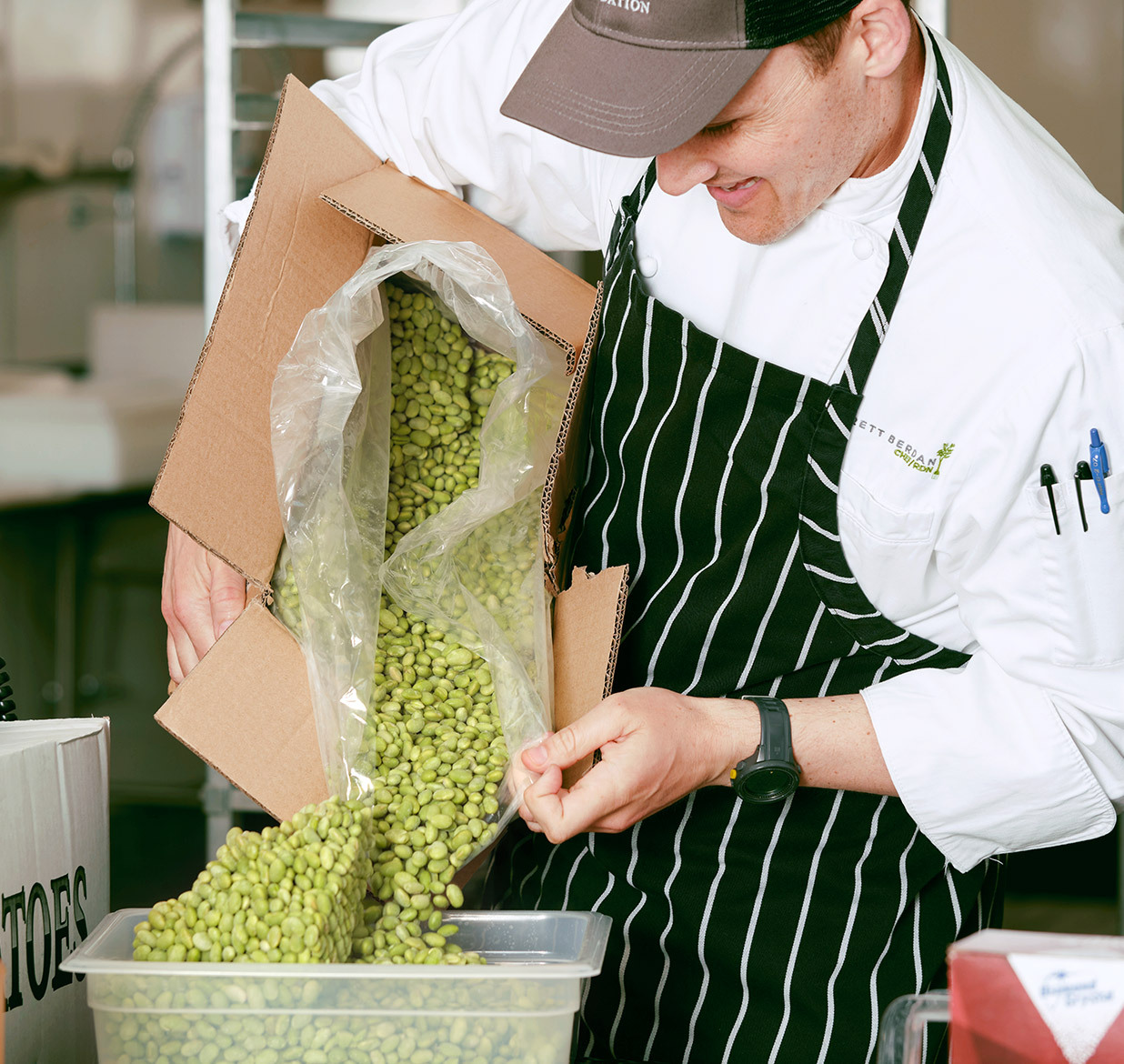
Salad Bars: Operations
Moving from concept to operation can be overwhelming: Which ingredients? What is the best combination of choices for each age-group? Which components to offer? How will staff estimate the ingredient needs? How much waste will be generated? What will the average cost be? The overwhelmingly popular use of salad bars in school food service usually disproves the concern that salad bars cost more to operate than a traditional line.

Salad Bars: Operations
Moving from concept to operation can be overwhelming: Which ingredients? What is the best combination of choices for each age-group? Which components to offer? How will staff estimate the ingredient needs? How much waste will be generated? What will the average cost be? The overwhelmingly popular use of salad bars in school food service usually disproves the concern that salad bars cost more to operate than a traditional line.
As with the other items in your meals, the costs are carried by all reimbursable meals sold. Just as with other menu components, the assumption is that the meal is “offer versus serve.” Not every student will take milk, not every student will take a roll, and not every student will take every item from the salad bar. At minimum, they will have to select a half cup of fruit or vegetable.
The cost of the individual components is carried by the averages of selection (the same as with all menu planning). If the budgeted cost per meal is $1.10, then that average may include menus that range from $0.90 cents to $1.40, depending on age-group and menu complexity. The salad bar becomes a standard part of that equation. Studies of districts have shown that average costs for the salad bar per elementary student ranges from $0.16 to $0.32. The range is based on the ingredient choice and volume and method of production (e.g., purchasing precut vegetables versus cutting whole products, percentage of USDA commodity foods used in the bar).
Salad Bar Layouts
A salad bar grid layout is a great tool for ensuring consistent costs and compliance at the site level, especially for the planned ingredient combinations that a menu planner outlined for compliance with the meal pattern. Salad bars are the most effective way for a menu planner to comply with the vegetable sub-groups and provide students with more frequent exposure and the opportunity to try these essential ingredients for lifelong health. These salad bar layout examples are just a few of a multitude of salad bar configurations that could be offered:

Example of 5-well salad bar setup

Example of 4-well salad bar setup
The layouts above can be offered daily as part of the reimbursable meal. Cold, intact whole grains and grain salads can be offered on the bar. However, it’s best to serve breads from the line to keep them from drying out on the salad bar. You can also use your salad bar to serve a fully reimbursable meal that offers all of the meal components (except milk): meat/meat alternate, grain, fruit, and vegetable.
To make this process easier, we have created an editable 4-Well Salad Bar Set-Up Template and 5-Well Salad Bar Set-Up Template. The template tools allow you to select pan sizes and configure layouts for either a four-well bar or a five-well bar. Using a consistent plan for ingredients helps determine approximate food costs. Pre-determined salad bar layouts are also helpful in training school teams in set-up and the salad bar’s role as a part of the reimbursable meal.
Salad bar layouts can be customized to respond to the location and resources of the school site. If the district has a bar with one-sided access, the selection of items will be smaller. In some districts, a mirrored approach works best for the flow of the line. Secondary schools will often support more complex choices without mirroring. In addition, the district may shift the combination of items offered to align with menu themes or to create seasonally driven selections. The salad bar is extremely flexible in that regard. Here are some additional examples of salad bar layouts, courtesy of Cloverleaf Local Schools in Ohio.
Menu Planning
Meal components on the salad bar provide an exciting opportunity for menu planning. School districts can exchange canned green beans and canned fruit cocktail—often seen as the eyesore of school food—with a rainbow of fresh products.
Once the salad bar becomes an assumed part of the operation, service is more efficient, directors are often creative with ingredient choice, and the staff is happy to take on the challenge. The key is to establish the baseline standards, train the team, and adjust for efficiency and sustainability.
Keep in mind, the first week of any salad bar launch usually has a very high participation rate, which will drop and level off as the students adjust to the salad bar as part of the daily meal.


Menu Planning
Meal components on the salad bar provide an exciting opportunity for menu planning. School districts can exchange canned green beans and canned fruit cocktail—often seen as the eyesore of school food—with a rainbow of fresh products.
Once the salad bar becomes an assumed part of the operation, service is more efficient, directors are often creative with ingredient choice, and the staff is happy to take on the challenge. The key is to establish the baseline standards, train the team, and adjust for efficiency and sustainability.
Keep in mind, the first week of any salad bar launch usually has a very high participation rate, which will drop and level off as the students adjust to the salad bar as part of the daily meal.
Portion Size
USDA guidance through Memo SP 31-2013 helped to establish guidelines for best practices with menu planning and production compliance. In the guidelines, page 2 addresses portion size:
- The planned portion size should be an amount that is reasonable for that menu item. For instance, a cup of lettuce would be reasonable, but a cup of radish would be more than a child would normally consume.
- When planning a salad bar as part of a reimbursable meal, the minimum portion sizes must be consistent with the meal pattern for the age-grade group. For example, when choosing fruits or vegetables from the salad bar to meet the fruit or vegetable component, a menu planner might determine that ½ cup of two or more different fruit or vegetables from the salad bar is the minimum for grades K-5, and grades 6-8, and ¾ cup of two or more different fruit or vegetables is the minimum for grades 9-12. Salad bars can also be used to serve one or multiple food components.
- It is important to remember that at least 1/8 cup of fruit or vegetable must be served to count towards the fruit or vegetable component, including those served on the salad bar. One of the challenges of a salad bar is to ensure that students actually take the minimum required portion size. Pre-portioning food items is one way that can assist staff in quickly identifying portion sizes. If not pre-portioning, then the cashier must determine if the food/menu item can count toward a reimbursable meal. Schools should consider placing signage as a visual aid to help students determine what a minimum portion is for self-service items, particularly in the case of leafy greens.
Many food service works are experts at recognizing eighth, quarter, half, three-quarter, and cup portions, and the students can become experts as well. When planning the salad bar set up, spoodles may seem like the best utensil to ensure proper portion sizes, but utensils should be chosen based on their ease of use. Recognizing that the salad bar components will be combined, and that we want the kids to choose several items for their meal, we recommend choosing utensils that are easy for kids to use with that ingredient. (Have you tried putting shredded carrots on your salad with a spoodle? It’s not ideal.) The goal should be to create a service environment where students can easily select multiple items without loading up their trays with more than they can eat. Use posters and signs as well as sample salads to demonstrate how combining vegetables creates a creditable portion.
The Recipe
In their salad bar guidance, the USDA describes how to create a salad bar recipe:
School Food Authorities (SFAs) are not required to conduct a nutrient analysis, however, many SFAs do monitor the nutrients provided in their menus and it can be a helpful tool to determine the nutrient composition of all the foods offered in the salad bar by considering the foods together as a “recipe”. A standardized recipe is a recipe that has been carefully adapted and tested to ensure that it will produce a consistent product every time it is used. Standardized recipes can be helpful when developing recipes for food bars because they promote consistent food quality, predictable yield, control food costs and help with inventory control. Creating a standardized recipe will also simplify the nutrient analysis process. The standardized recipe should be constructed based on a typical day.
When the USDA says “considering the foods together as a ‘recipe’,” it means that every ingredient you offer on the salad bar is included in the “recipe.” One student might have only lettuce and tomato while another may choose pear, rice salad, carrots, and beets. The role of the recipe is to ascertain a nutrient analysis of all the items selected by all your students over a set period of time. In our recipe, we recommend using a week of data to create the recipe.
Though typically districts create recipes and then make the food, in this case, you need to offer the salad bar and let the students settle into a routine before making decisions based on the data. We recommend collecting the data using a five-day production record that tracks the product prepared and used by ingredient.
To simplify the task of measuring how much product is prepared and used, we recommend creating standard measures for each product by using the pan used on the bar as the measure. In the example below, you can see that each ingredient is identified by a pan size, the product weight per pan, and the ingredient serving size, if served alone. One of the common missteps of implementation is that districts do not create standard measures for bulk pans of ingredients that are used daily in the layout. As a result, their ability to track prepared and used product is often compromised.
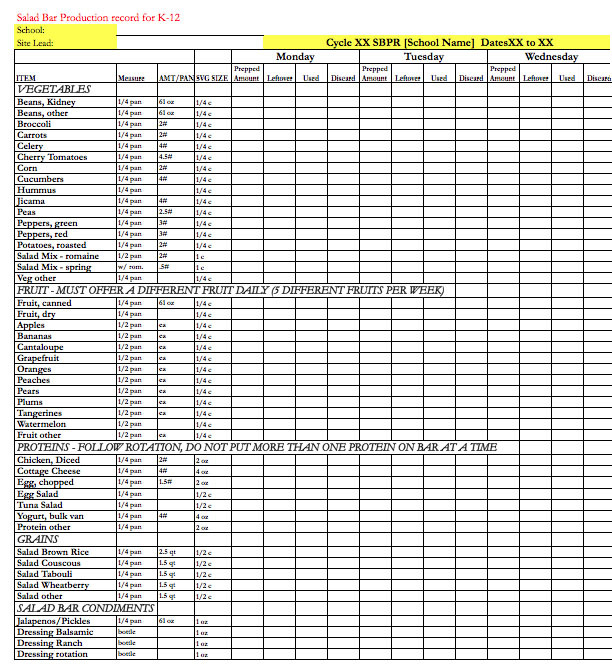
To create a unit of measure for the pans, prep and weigh each item offered on the salad bar. The line on the pan—which is approximately two-thirds up the side of the pan—is the “fill mark.” We recommend creating these standard measures for the bar because it provides speed and accuracy at the site level, both for inventory and ordering. Without any further measuring, staff can easily determine how much of a pan is leftover, how many pans were used, etc.
The use of scales is also an accurate and an acceptable method if the school is changing pan sizes often or does not have a standardized daily layout. To use a scale to track production, the staff person would weigh the total product prepped before service and then weigh it again after service.
PICTURED LEFT: Sample production record

To create a unit of measure for the pans, prep and weigh each item offered on the salad bar. The line on the pan—which is approximately two-thirds up the side of the pan—is the “fill mark.” We recommend creating these standard measures for the bar because it provides speed and accuracy at the site level, both for inventory and ordering. Without any further measuring, staff can easily determine how much of a pan is leftover, how many pans were used, etc.
The use of scales is also an accurate and an acceptable method if the school is changing pan sizes often or does not have a standardized daily layout. To use a scale to track production, the staff person would weigh the total product prepped before service and then weigh it again after service.
PICTURED LEFT: Sample production record
Real-World Examples
In the district where this sample production record was sourced, all 50 schools have salad bars and the regional managers review the data at the completion of each six-week cycle.
The menu planner updates the recipes as needed. The ingredient measures for the recipes are based on real usage data gathered by adding together the weekly totals by ingredient and school, which are then divided by the number of meals served for the week. The recipe reflects every ingredient offered on the salad bar. This is an accurate representation of the average consumption of the salad bar ingredients in the district for the week measured.
ABOVE LEFT TO RIGHT: Side salad recipe used for everyday salad bar in elementary and K-8 sites (cropped); Side of fruit recipe, which reflects the various fruit choices offered on the bar (cropped).
In the above examples, the district also created a fruit recipe for all the seasonal fruits that might be served throughout the year. This district limits the use of canned fruit in the elementary grades, and it is not used at all in the secondary grades. Aside from maintaining the detailed by-item production records for development of the recipe, maintaining these records allows for the sites to develop realistic weekly produce orders. Maintaining detailed records provides accountability and cost containment by reducing over-ordering. You can find salad bar recipes in the School Recipes & Menus section of The Lunch Box; select “Salads” from the pull down menu.
Recordkeeping
As part of the reimbursable meal, salad bars create a challenge for the NSLP production records used for meal claiming. The most common accountability method is to add each ingredient offered to either paper or digital production records with the attendant serving size for the item. Many districts will preprint all the items offered and the site manager will check or circle which items they offered and estimate how many servings of each were prepared, served, and left over.
This type of accountability does not truly reflect the way salad bars operate. Students do not typically choose a half-cup of carrot or a cup of lettuce. They are most likely combining several items to comprise the required serving (at minimum).
Another method is to schedule the “side salad” recipe and the “fruit” recipes to the production record as well as maintain the detailed ingredient production record, described earlier, for accountability and efficiency. When the side salad is listed in the production record, the detailed by-item Salad Bar Production Record backs up the volume of product that was prepared, reflecting that planned quantities produced were adequate for the reimbursable meals served that day (ensuring meal compliance). In the production record, the reimbursable meal count for the day is used as the “served” or “used” quantity for side salad. For example, if a site served 100 reimbursable meals, then 100 would be recorded for the line item “SB Side Elem.” The fruit side can be treated the same way. This method accounts for the individual choices students make at the salad bar, which typically is more than two items.
For a la carte side salads sold, there should be an item record from the POS software to record into the “non-reimbursable” field, indicating exactly how many were sold to brown baggers or adults (you may have developed a separate recipe for adults). If a school does not use a POS system, the easiest way to track non-reimbursable salad sales is to count the side salad containers before service and then record the number used by counting the remaining containers at the end of service. That method can also be used to count reimbursable salad bar meals if a school has not created a key for a reimbursable salad bar meal in the POS.
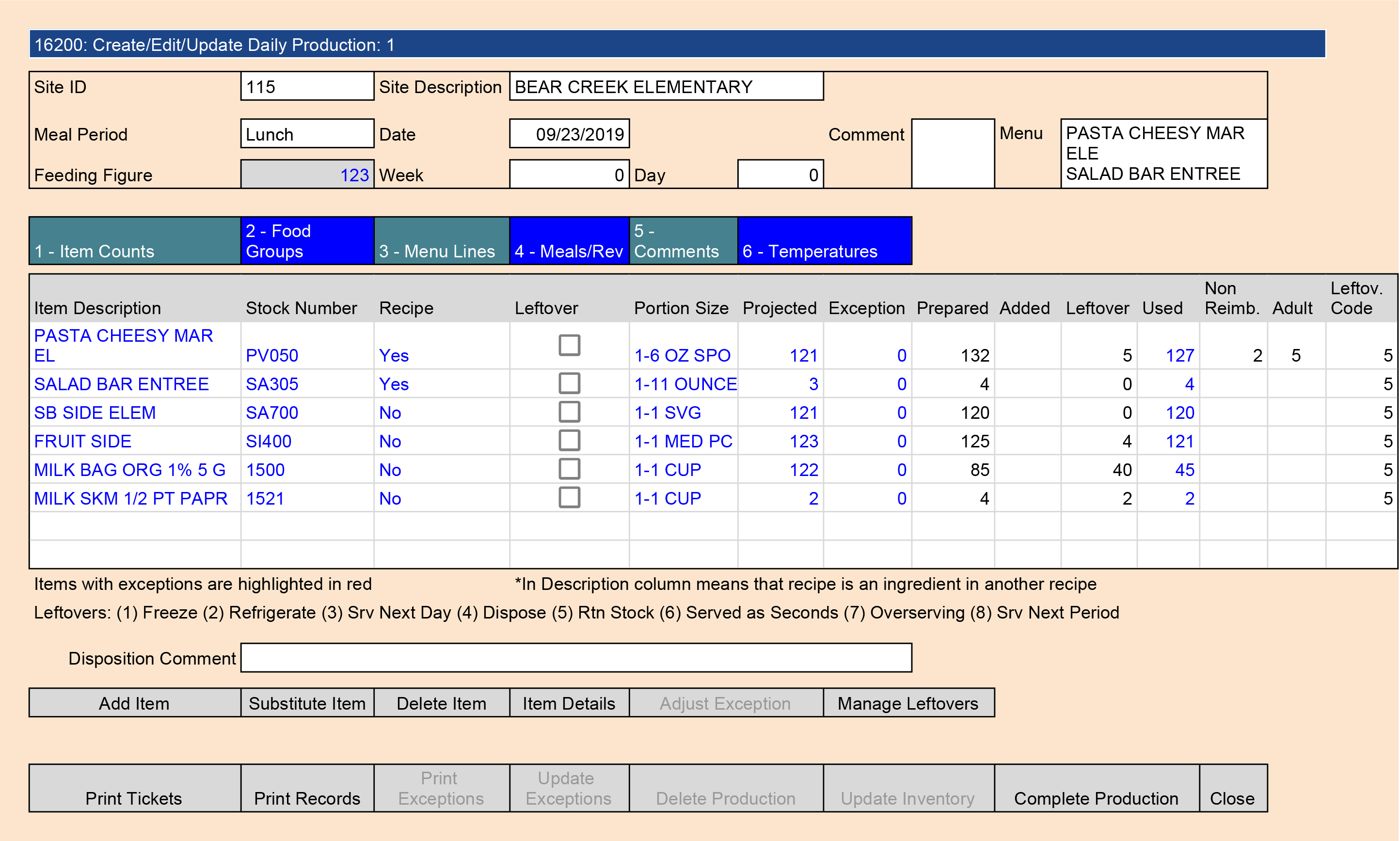
ABOVE: By-item production record
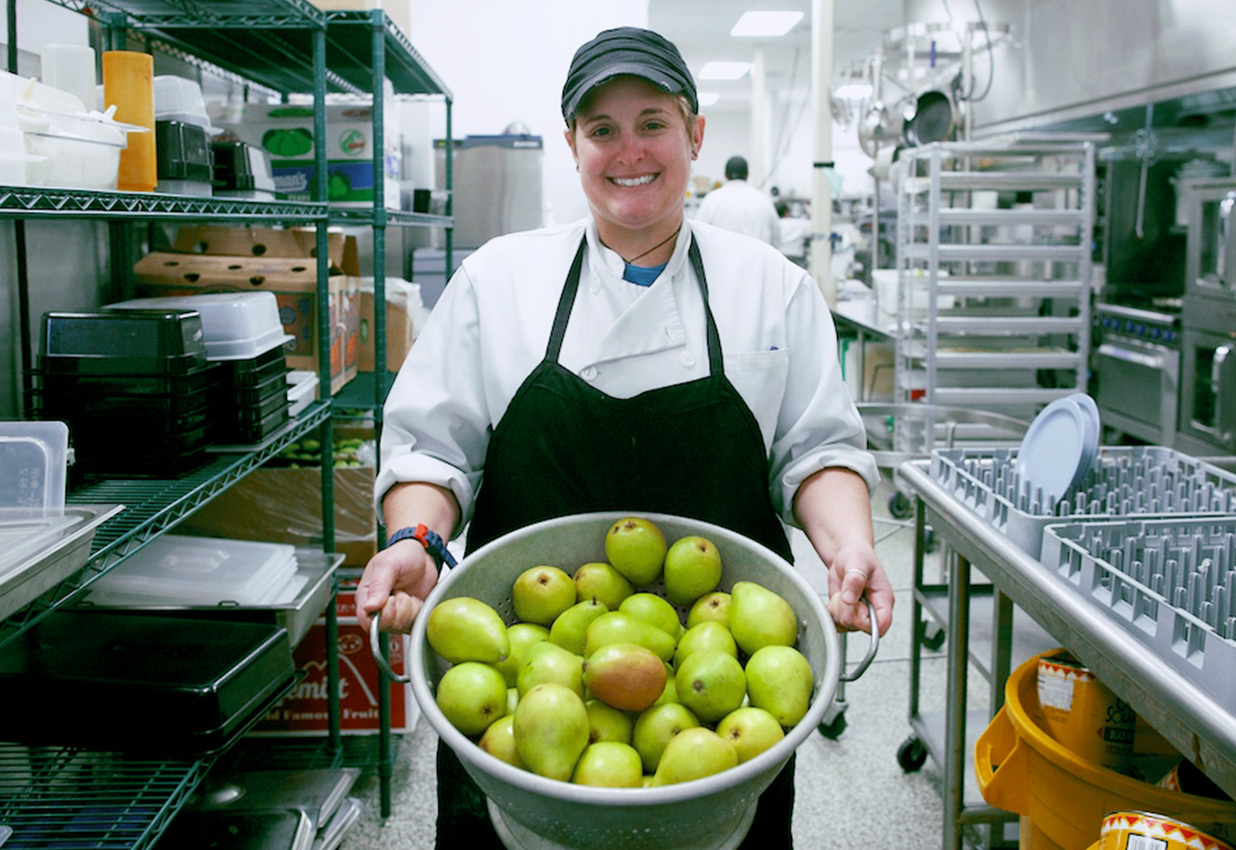
Site Level Ordering
The use of detailed daily production records is essential to the site management of salad bars. Cost overruns due to waste at the site level is one of the most common reasons that salad bar programs fail. Depending on the operational model, the site staff’s role in fiscal sustainability of the salad bar program is extremely important.

Site Level Ordering
The use of detailed daily production records is essential to the site management of salad bars. Cost overruns due to waste at the site level is one of the most common reasons that salad bar programs fail. Depending on the operational model, the site staff’s role in fiscal sustainability of the salad bar program is extremely important.
There is more protection against waste in a centralized production model, since many or all of the salad bar products are ordered and shipped from a central kitchen. Central production allows for more efficient production of cut products, and ordering by sites is simpler because they order by standard measures of prepared product instead of raw product that requires prep on site. This is especially useful for small school sites where receiving a case of a product (like cucumbers) is not in scale with the rate the product is used.
In the instance where small sites must prep product from scratch, the district may need to specify with the vendor that broken cases or buying product by the pound will be required. Another solution includes splitting cases between sites—one site receives the full case, splits it, and then a driver moves the balance of the case to the other site. Tracking expenses by site can be challenging with this method, but you can use inventory transfers and site accounting codes on the invoices.
The USDA’s Food Buying Guide, which is now available in an online tool, is helpful in estimating the edible portion of many common salad bar vegetables. Accurate production record keeping is the quickest way to ascertain actual needs. You can also customize the Salad Bar Site Produce Projection Tool by scaling the yield of key vegetable ingredients in the salad bar recipe.
SOPs, Training, & Support
Salad Bars represent a significant service model shift for any district. To prepare the team, the director should provide training that includes how the salad bar impacts the menu plan, product ordering and preparation, setting up and breaking down the bar, and addressing meal service with a salad bar. For most school districts, adding a salad bar means that the service line will continue from the hot food line into the cafeteria. The point of sale might also move, since it must be placed after the salad bar. These are significant shifts in the school site team’s daily routine and require practice to master. Budgeting time and funds for staff training is part of the process.
Salad bar operating plans should be developed for central kitchen and/or satellite or stand-alone kitchens as applicable. Standard Operating Procedures (SOPs) that include salad bars as part of the menu and service are essential to a district’s success. SOPs can be customized to fit various physical plants and labor models, but the overall goals are the same: to operate the bar efficiently and safely.
Procedures should include guidelines for purchasing, receiving, storing, rinsing, processing, holding, transporting, temperature logging, and serving of fresh produce, with specific guidelines for the handling of temperature controlled for safety (TCS) and Potentially Hazardous Foods (PHF) as shown in the illustration below. Key features of a salad bar SOP include:
- Sanitation
- Consistent use of temp logs (see a sample of a Temperature Log)
- Chilling pans used on the bar
- Plenty of utensil and ingredient back-ups
- Set up a pattern of rotating out products through meal periods
- Customer Service
- Menu and Salad Bar ingredient layout
- Ordering, receiving, inventory
- Preparation
- Record keeping compliance (counting)
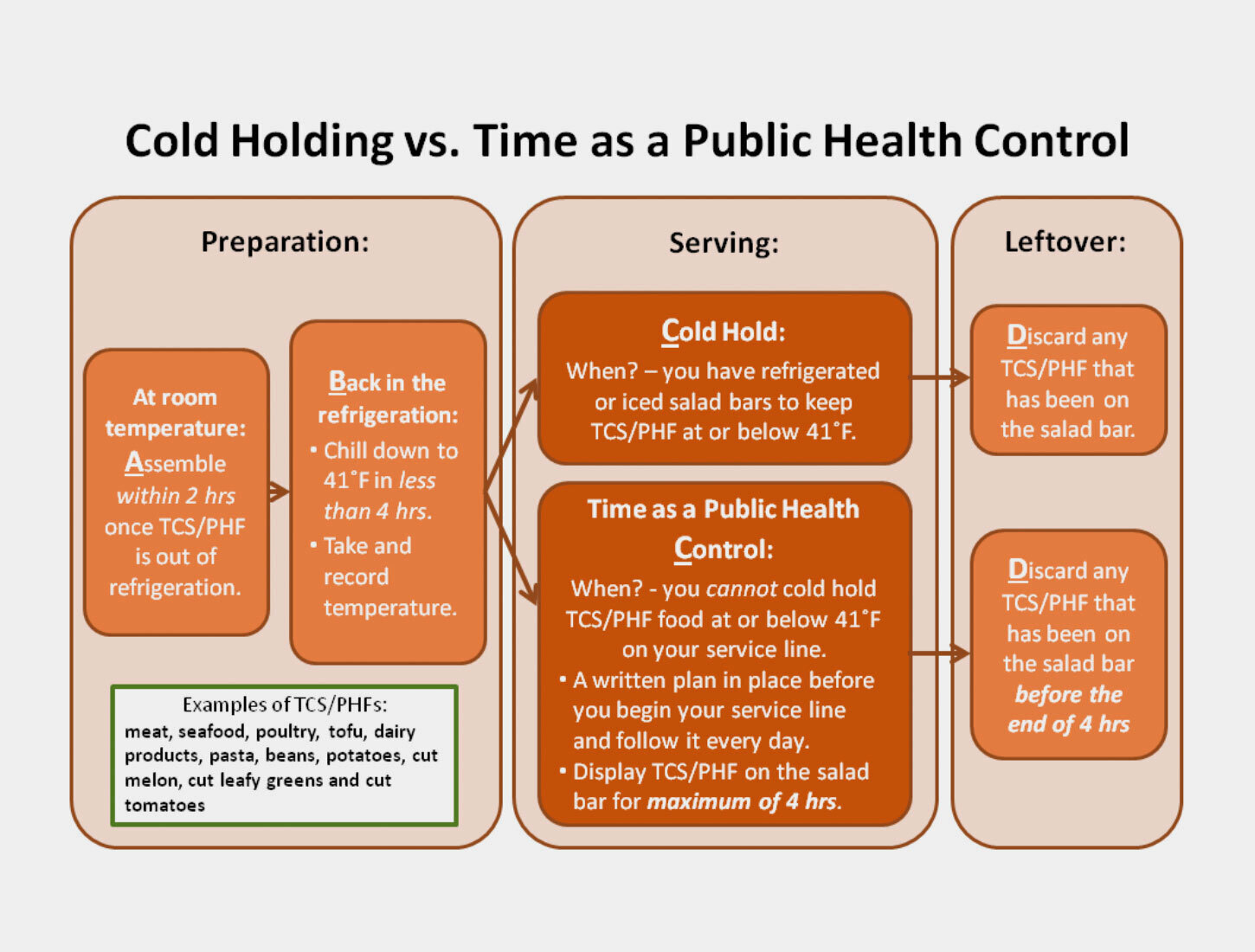

Procedures should include guidelines for purchasing, receiving, storing, rinsing, processing, holding, transporting, temperature logging, and serving of fresh produce, with specific guidelines for the handling of temperature controlled for safety (TCS) and Potentially Hazardous Foods (PHF) as shown in the illustration below. Key features of a salad bar SOP include:
- Sanitation
- Consistent use of temp logs (see a sample of a Temperature Log)
- Chilling pans used on the bar
- Plenty of utensil and ingredient back-ups
- Set up a pattern of rotating out products through meal periods
- Customer Service
- Menu and Salad Bar ingredient layout
- Ordering, receiving, inventory
- Preparation
- Record keeping compliance (counting)
Dedicated professional development days or half days are ideal for group trainings. Many districts rollout a salad bar at one site until it is running smoothly, and then use that school as a training location for the subsequent school team. Whether the director performs a group training or uses the first launch site for on-going and subsequent training, an outline of salad bar training that aligns with individual district set up can be very helpful. Short “refresher” trainings can also be developed and performed annually as part of the Professional Standards training hour requirements.
Staff, as well as volunteers and regular lunchroom supervisors (e.g. vice principals, aides, teachers), are important to the overall follow-through of salad bar procedures. By educating them on proper use of the salad bar, you can ensure long-term success of the program. Marketing Posters and Signs can educate students, and be doubly helpful in unison with a trained support team. Community acceptance of the salad bar will happen once everyone experiences the students’ excitement and delight in having more fresh food choices.
Recommended Next Topic: Salad Bar Training
Salad bars change the culture of school cafeterias and present a new opportunity for students to learn and engage with school meals. For school administration, principals, teachers, parents, and community, salad bars represent a tangible example of what “eating healthy” can look like.
Recommended Next Topic: Salad Bar Training
Salad bars change the culture of school cafeterias and present a new opportunity for students to learn and engage with school meals. For school administration, principals, teachers, parents, and community, salad bars represent a tangible example of what “eating healthy” can look like.






